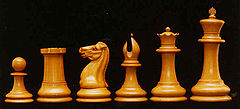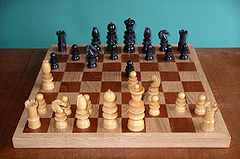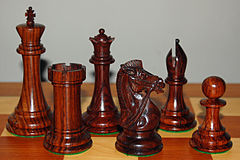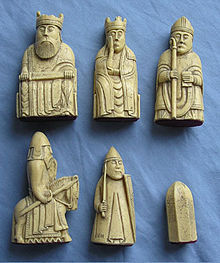
- Chess World Cup
- FIDE Grand Prix
- Olympiad
- World Championship
- List of strong tournaments
- List of world championships

- Checkmate patterns
- Chess openings
- Chess strategy
- Chess tactics
- Chess theory
- Endgames
- Pawn structure
- Problems/Compositions












 Original Staunton chess pieces, left to right: pawn, rook, knight, bishop, queen, and king
Original Staunton chess pieces, left to right: pawn, rook, knight, bishop, queen, and king  |
King |
|---|---|
  |
Queen |
  |
Rook |
  |
Bishop |
  |
Knight |
  |
Pawn |
A chess piece, or chessman, is any of the 32 movable objects deployed on a chessboard used to play the game of chess. In a standard game of chess, each of the two players begins a game with the following 16 pieces:
In playing chess, the players take turns moving one of their own chess pieces. The rules of chess prescribe the types of move a player can make with each type of chess piece.
The pieces that belong to each player are distinguished by color. The lighter colored pieces, and the player that plays them, are referred to as white. The darker colored pieces and their player are referred to as black.
In chess, the word "piece" has three meanings, depending on the context.
The context should make the intended meaning clear (Burgess 2009:523) (Hooper & Whyld 1992:307).
Read main article: Rules of chess
| a | b | c | d | e | f | g | h | ||
| 8 |

                                |
8 | |||||||
| 7 | 7 | ||||||||
| 6 | 6 | ||||||||
| 5 | 5 | ||||||||
| 4 | 4 | ||||||||
| 3 | 3 | ||||||||
| 2 | 2 | ||||||||
| 1 | 1 | ||||||||
| a | b | c | d | e | f | g | h | ||
Each piece type moves in a different way.
Pieces other than pawns capture in the same way that they move. A capturing piece replaces the opponent piece on its square, except for an en passant capture. Captured pieces are immediately removed from the game. A square may hold only one piece at any given time. Except for castling and the knight's move, no piece may jump over another piece (Just & Burg 2003:13-16).
 A St. George style set
A St. George style setThe variety of designs available is broad, from small cosmetic changes to highly abstract representations, to themed designs such as those that emulate the drawings from the works of Lewis Carroll, or modern treatments such as Star Trek or The Simpsons. Themed designs are generally intended for display purposes rather than actual play (Hooper & Whyld 1992:76). Some works of art are designs of chess sets, such as the modernist chess set by chess enthusiast and dadaist Man Ray, that is on display in the Museum of Modern Art in New York City.
Chess pieces used for play are usually figurines that are taller than they are wide. For example, a set of pieces designed for a chessboard with 2.25 inches (57 mm) squares typically have a king around 3.75 inches (95 mm) tall. Chess sets are available in a variety of designs, with the most well-known Staunton design, named after Howard Staunton, a 19th-century English chess player, and designed by Nathaniel Cook. The first Staunton style sets were made in 1849 by Jaques of London (also known as John Jaques of London and Jaques and Son of London) (Just & Burg 2003:225).
 Staunton pieces made of rosewood
Staunton pieces made of rosewood Staunton pieces made of plastic
Staunton pieces made of plasticWooden White chess pieces are normally made of a light wood, boxwood, or sometimes maple. Black wooden pieces are made of a dark wood such as rosewood, ebony, red sandalwood, or walnut. Sometimes they are made of boxwood and stained or painted black, brown, or red. Plastic white pieces are made of white or off-white plastic, and plastic black pieces are made of black or red plastic. Sometimes other materials are used, such as bone, ivory, or a composite material (Just & Burg 2003:224,226).
 Staunton chess pieces on chess board with chess clock
Staunton chess pieces on chess board with chess clockFor actual play, pieces of the Staunton chess set design are standard. The height of the king should be between 3.35 to 4.13 inches (85 to 105 millimetres). United States Chess Federation rules call for a king height between 3.375 and 4.5 inches (86 to 114 mm). A height of about 3.75 to 4 inches (95 to 102 millimetres) is preferred by most players. The diameter of the king should be 40-50% of its height. The size of the other pieces should be in proportion to the king. The pieces should be well balanced. The length of the sides of the squares of the chessboard should be about 1.25-1.3 times the diameter of the base of the king, or 2 to 2.5 inches (51 to 64 millimetres). Squares of about 2.25 inches (57 mm) are normally well suited for pieces with the kings in the preferred size range. These criteria are from the United States Chess Federation's Official Rules of Chess, which is based on the Fédération Internationale des Échecs rules (Just & Burg 2003:224-27).
The Grandmaster Larry Evans offered this advice on buying a set (Evans 1973:18):
Make sure the one you buy is easy on the eye, felt-based, and heavy (weighted). The men should be constructed so they don't come apart. ... The regulation board used by the U. S. Chess Federation is green and buff - never red and black. However, there are several good inlaid wood boards on the market. ... Avoid cheap equipment. Chess offers a lifetime of enjoyment for just a few dollars well spent at the outset.
Some small magnetic sets, designed to be compact and/or for travel, have pieces more like those used in shogi and xiangqi - each piece being a similar flat token, with a symbol printed on it to identify the piece type.
On computers, chess pieces are often 2D symbols on a 2D board, although some programs have 3D graphics engines with more traditional designs of chess pieces.
Unicode contains symbols for chess pieces in both white and black.
Read main article: Chess piece relative value
The value assigned to a piece attempts to represent the potential strength of the piece in the game. As the game develops, the relative values of the pieces will also change. A bishop positioned to control long, open diagonal spaces is usually more valuable than a knight stuck in a corner. Similar ideas apply to placing rooks on open files and knights on active, central squares. The standard valuation is one point for a pawn, three points for a knight or bishop, five points for a rook, and nine points for a queen (Hooper & Whyld 1992:438-39). These values are general throughout a game; in specific circumstances the values may be quite different - a knight can be more valuable than a queen in a particular decisive attack.
| Language | King | Queen | Rook | Bishop | Knight | Pawn | Chess | Check | Checkmate |
|---|---|---|---|---|---|---|---|---|---|
| figurine | ♔ ♚ | ♕ ♛ | ♖ ♜ | ♗ ♝ | ♘ ♞ | ♙ ♟ | ... | + | # |
| Afrikaans | K Koning (king) |
D Dame (lady) |
T Toring (tower) |
L Loper (runner) |
R Ruiter (rider) |
(P) Pion | Skaak | Skaak | Skaakmat |
| Albanian | M Mbreti (king) |
Msh Mbretëresha (queen) |
Ku Kulla (tower) |
O Oficeri (officer) |
Ka Kali (horse) |
(U) Ushtari (soldier) |
Shahu | Shah | Shah mat |
| Arabic | م مَلِك (malik, king) |
و وزير (wazïr, vizier) |
ر رخ/طابية (rukhkh, fortress) / (ṭābiya, castle) |
ف فيل (fīl, elephant) |
ح حصان (ħiṣān, horse) |
ب بيدق/عسكري (baidaq, pawn) / (`askarī, soldier) |
شطرنج (shaṭranj) |
كِش مَلِك (kish malik) |
كِش مات (kish māt) |
| Armenian | Ա Արքա (A Ark῾a, king) |
Թ Թագուհի (T T῾agowhi, queen) |
Ն Նավակ (N Navak, ship) |
Փ Փիղ (P P῾ił, elephant) |
Ձ Ձի (Dz Ji, horse) |
Զ Զինվոր (Z Zinvor, soldier) |
Շախմատ (Ճատրակ) Šaxmat (Čatrak) |
Շախ (Šax) |
Մատ (Mat) |
| Basque | E Erregea (king) | D Dama (lady) | G Gaztelua (castle) | A Alfila (bishop) | Z Zaldula | (P) Peoia (pawn) | Xake | Xake | Xake mate |
| Belarusian | К кароль (king) |
Вз візыр (queen) |
Лд ладзьдзя (rook) |
А афіцэр (officer) |
В вершнік (rider) |
(Л) латнік (pawn) |
Шахматы | Шах | Мат |
| Bengali | R রাজা (Raja) |
M মন্ত্রী (Montri) |
N নৌকা (Nouka) |
H গজ/হাতি (Goj)/(Hati) |
G ঘোড়া (Ghora) |
B বোড়া/সৈন্য/পেয়াদা (Bora)/(Sainya)/(Peyada) |
দাবা (daba) | কিস্তি (kisti) |
কিস্তিমাৎ (kistimat) |
| Bulgarian | Ц цар (king) |
Д дама (lady) |
Т топ (cannon) |
О офицер (officer) |
К кон (horse) |
(П) пешка | Шахмат/Шах | Шах | (Шах и) мат |
| Catalan | R rei | D dama/reina (lady)/(queen) |
T torre (tower) |
A alfil | C cavall (horse) |
(P) peó | Escacs | Escac/Xec | Escac i mat |
| Chinese | K 王 (Wáng, king) |
Q 后 (Hòu, queen) |
R 車 (Jū, chariot) |
B 象 (Xiàng, elephant) |
N 馬 (Mǎ, horse) |
(P) 兵 (Bīng, soldier) |
國際象棋 (Guójì Xiàngqí) |
將軍 (Jiāngjūn, general) |
將死 (Jiāngsǐ, checkmate) |
| Czech | K král (king) |
D dáma (lady) |
V věž (tower) |
S střelec (shooter) |
J jezdec (rider) |
(P) pěšec (foot soldier) |
Šachy | Šach | Mat |
| Danish | K konge (king) |
D dronning (queen) |
T tårn (tower) |
L løber (runner) |
S springer (jumper) |
(B) bonde (peasant) |
Skak | Skak | Skakmat |
| Dutch | K koning (king) |
D dame/koningin (lady)/(queen) |
T toren/kasteel (tower)/(castle) |
L loper/raadsheer (runner)/(counsellor) |
P paard (horse) |
(pi) pion | Schaken | Schaak | Mat/Schaakmat |
| English | K king | Q queen | R rook | B bishop | N/Kt knight | (P) pawn | Chess | Check | Checkmate |
| Esperanto | R reĝo (king) |
D damo (lady) |
T turo (tower) |
K kuriero (courier) |
Ĉ ĉevalo (horse) |
(P) peono | Ŝako | Ŝak | Ŝakmato |
| Estonian | K kuningas (king) |
L lipp | V vanker | O oda | R ratsu | (E) ettur | Male | Tuli | Matt |
| Finnish | K kuningas (king) |
D daami/kuningatar (lady)/(queen) |
T torni (tower) |
L lähetti (messenger) |
R ratsu (horse) |
(S) sotilas (soldier) |
Shakki | Shakki | Matti/Shakkimatti |
| French | R roi (king) |
D dame (lady) |
T tour (tower) |
F fou (jester) |
C cavalier (rider) |
(P) pion | Échecs | Échec | Échec et mat |
| Georgian | მ მეფე (Mep'e) |
ლ ლაზიერი (Lazieri) |
ე ეტლი (Etli) |
კ კუ (Ku) |
მ მხედარი (Mkhedari') |
პ პაიკი (Paiki) |
ჭადრაკი (Čadraki) | ქიში (K'ishi) |
შამათი (Shamat'i) |
| German | K König (king) |
D Dame (lady) |
T Turm (tower) |
L Läufer (runner) |
S Springer/Pferd (jumper)/(horse) |
(B) Bauer (peasant) |
Schach | Schach | Matt/Schachmatt |
| Greek | Ρ βασιλιάς (vasiliás, king) |
Β βασίλισσα (vasílissa, queen) |
Π πύργος (pýrgos, tower) |
Α αξιωματικός (axiomatikós, officer) |
Ι ίππος (íppos, horse) |
(Σ) πιόνι (pióni, pawn) |
Σκάκι (Skáki) |
Σαχ (Sach) |
Mατ (Mat) |
| Hebrew | מ מלך (Melech, king) |
מה מלכה (Malka, queen) |
צ צריח (Tzariach, tower) |
ר רץ (Ratz, runner) |
פ פרש (Parash, rider) |
רגלי (Regli, foot-soldier) |
שחמט (Shakhmat) |
שח (Shakh) |
מט (Mat) |
| Hindi | R राजा (rājā, king) |
V वज़ीर (vazīr, vizier) |
H हाथी (hāthī, elephant) |
O ऊँट (ūṁṭ, camel) |
G घोड़ा (ghoṛā, horse) |
(P) प्यादा (pyādā, infantryman) |
शतरंज (Shatranj) |
शाह (Shāh) |
शाहमात (Shāhmāt) |
| Hungarian | K király (king) |
V vezér/királynõ (commander)/(queen) |
B bástya (bastion) |
F futó (runner) |
H huszár/ló (hussar)/(horse) |
(Gy) gyalog/paraszt (footman)/(peasant) |
Sakk | Sakk | Matt |
| Icelandic | K kóngur (king) |
D drottning (queen) |
H hrókur | B biskup (bishop) |
R riddari (knight) |
(P) peð | Skák | Skák | Skák og mát |
| Indonesian | R raja (king) |
M menteri (minister/vizier) |
B benteng (castle/fortress) |
G gajah (elephant) |
K kuda (horse) |
(P) pion | Catur | Skak | Skak mati |
| Irish | R rí (king) |
B banríon (queen) |
C caiseal (bulwark) |
E easpag (bishop) |
D ridire (knight) |
(F) fichillín/ceithearnach | Ficheall | Sáinn | Marbhsháinn |
| Italian | R re (king) |
D donna (lady) |
T torre (tower) |
A alfiere (standard-bearer) |
C cavallo (horse) |
(P) pedone | Scacchi | Scacco | Scacco matto |
| Japanese | K キング (kingu) |
Q クイーン (kuīn) |
R ルーク (rūku) |
B ビショップ (bishoppu) |
N ナイト (naito) |
(P) ポーン (pōn) |
チェス (chesu) |
王手/ チェック (chekku) |
詰み/ チェックメイト (chekkumeito) |
| Korean | K 킹 (king) |
Q 퀸 (kwin) |
R 룩 (rug) |
B 비숍 (bi syob) |
N 나이트 (na i teu) |
(P) 폰 (pon) |
체스 (ce seu) |
체크 (ce keu) |
체크메이트 (ce keu me i teu) |
| Latin | R rex | G regina | T turris | E episcopus | Q eques | (P) pedes | Scacci | Scaccus | Mattus |
| Latvian | K karalis (king) |
D dāma (lady) |
T tornis (tower) |
L laidnis (bishop) |
Z zirgs (cavallo) |
(B) bandinieks | Šahs | Šahs | Šahs un mats |
| Lithuanian | K karalius | V valdovė | B bokštas | R rikis | Ž žirgas | (P) pėstininkas | Šachmatai | Šach | Matas |
| Luxembourgish | K kinnek | D damm | T tuerm (tower) |
L leefer (runner) |
P päerd (horse) |
(B) bauer (farmer) |
Schach | Schach | Schachmatt |
| Malayalam | K രാജാവ് (rajavu) |
Q മന്ത്രി (manthri) |
R തേര് (theru) |
B ആന (anaa) |
N/Kt കുതിര (kuthira) |
(P) കാലാള് / പടയാളി (kalal)/(padayali) |
ചതുരംഗം (chathurangam) |
ചെക്ക് check |
ചെക്ക് മേറ്റ് check mate |
| Marathi | R राजा (rājā) |
V वज़ीर (vajīr) |
H हत्ती (hātti) |
O उंट (Uant) |
G घोड़ा (ghoda) |
(P) प्यादे (pyāde) |
बुद्धिबळ (buddhibal) |
शह (shāh) |
शहमात (shāhmāt) |
| Mongolian | Н ноён (lord) |
Б бэрс (ferz) |
т тэрэг (chariot) |
Т тэмээ (camel) |
М морь (rider) |
(Х) хүү (paige) |
Шатар | шаг, дуг, цод | мад |
| Norwegian Bokmål | K konge (king) |
D dronning (queen) |
T tårn (tower) |
L løper (runner) |
S springer (jumper) |
(B) bonde (peasant) |
Sjakk | Sjakk | Sjakkmatt |
| Norwegian Nynorsk | K konge (king) |
D dronning (queen) |
T tårn (tower) |
L løpar (runner) |
S springar (jumper) |
(B) bonde (peasant) |
Sjakk | Sjakk | Sjakkmatt |
| Persian | ش شاه | و وزیر | ق/ر قلعه/رخ | ف فیل | ا اسب | س سرباز | شطرنج | کیش | مات |
| Polish | K król (king) |
H hetman | W wieża (tower) |
G goniec (courier) |
S skoczek (jumper) |
(P) pion (pawn) |
szachy | szach | mat (szach-mat / szach i mat) |
| Portuguese | R rei (king) |
D dama/rainha (lady)/(queen) |
T torre (tower) |
B bispo (bishop) |
C cavalo (horse) |
(P) peão | Xadrez | Xeque | Xeque-mate |
| Romanian | R rege (king) |
D damă/regină (lady)/(queen) |
T turn (tower) |
N nebun (fool, jester) |
C cal (horse) |
(P) pion | Şah | Şah | Mat |
| Russian | Кр король (king) Kr korol' |
Ф ферзь (from Persian vizier) F ferz' |
Л ладья (boat) L ladʹjá |
С слон (elephant) S slon |
К конь (horse) K kon' |
(П) пешка P péška |
шахматы šáxmaty |
шах šax |
мат mat |
| Serbo-Croatian | К/K краљ / kralj | Д/D краљицa / kraljica | Т/T топ / top | Л/L ловац / lovac | С/S скaкaч / skakač | (П) пjешак / pješak | Шах / Šah | Шах / Šah | Мат / Mat |
| Northern Sotho | К Kgoši | Kg Kgošigadi | N Ntlosebô/Moshate | Mp Mopišopo | M Mogale | S Seitšhireletšo | Chess | Check | Checkmate |
| Sicilian | R re | D riggina | T turru | A alferu | S scecchu | (P) pidinu | Scacchi | ||
| Slovak | K kráľ | D dáma | V veža | S strelec | J jazdec | (P) pešiak | Šach | Šach | Mat/Šachmat |
| Slovene | K kralj | D dama | T trdnjava | L lovec | S skakač | (P) kmet | Šah | Šah | Mat/Šahmat |
| Spanish | R rey (king) |
D dama/reina (lady/queen) |
T torre (tower) |
A alfil | C caballo (horse) |
(P) peón (foot-soldier) |
Ajedrez | Jaque | Jaque mate |
| Swedish | K kung | D dam/drottning (lady)/(queen) |
T torn (tower) |
L löpare (runner) |
S springare/häst (horse) |
(B) bonde (peasant) |
Schack | Schack | Schack matt |
| Tamil | K அரசன் (arasaṉ) |
Q அரசி (arasi) |
R கோட்டை (kōṭṭai) |
B அமைச்சர் / மந்திரி (amaicchar) / (manthiri) |
N/Kt குதிரை (kuthirai) |
(P) காலாள் / சிப்பாய் (kālāḷ) / (cippāy) |
சதுரங்கம் (sathurankam) |
முற்றுகை (muṟṟukai) |
இறுதி முற்றுகை (iṟuti muṟṟukai) |
| Telugu | రాజు (rāju) |
మంత్రి (maṃtri) |
ఏనుగు (ēnugu) |
శకటు (śakaţu) |
గుర్రం (gurraṃ) |
బంటు (baṃţu) |
చదరంగం (cadaraṃgaṃ) |
దాడి (dāḍi) |
కట్టు (kaţţu) |
| Thai | ข ขุน (khun, king) |
ต เม็ด (ตรี/มนตรี) (met (trī/montrī), counselor) |
ร เรือ (reūa, ship) |
ค โคน (khōn, elephant) |
ม ม้า (mā, horse) |
(บ) เบี้ย (bīa, menial) |
หมากรุก (mākruk) |
รุก (ruk, invade) |
จน (jon, checkmate) |
| Turkish | Ş/K şah/kral | V vezir | K kale | F fil | A at | (P) er/piyon | Satranç | Şah | Mat |
| Ukrainian | Kр король | Ф ферзь | T тура | C слон | K кінь | (П) пішак | Шахи | Шах | Мат |
| Urdu | بادشاہ (bādshāh) |
وزیر (vazīr) |
رخ (rukh) |
فيلہ (fiyalah) |
گھوڑا (ghōṛā) |
پیادہ (pyādah) |
شطرنج (šaṭranj) |
شہ (sheh) |
شہمات (shehmāt) |
| Vietnamese | V Vua | H Hậu | X Xe | T Tượng | M Mã | _ Tốt | Cờ vua | Chiếu | Chiếu bí/Chiếu hết |
| Welsh | T teyrn/brenin | B brenhines | C castell | E esgob | M marchog | (G) gwerinwr | Gwyddbwyll | Siach | Siachmat |
(Luiro 2009)
 Lewis chessmen
Lewis chessmen